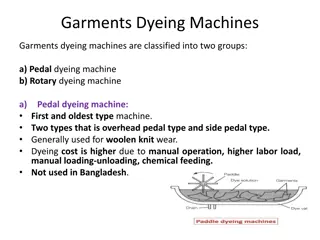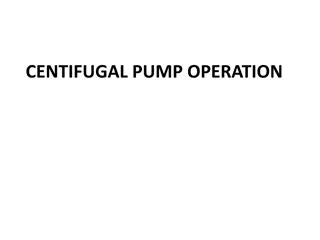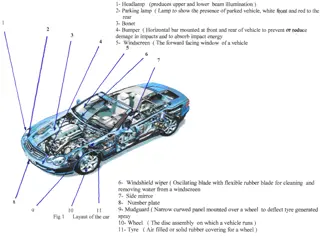Theory of Machines and Centrifugal Clutches
In theory of machines, centrifugal clutches are essential components used in motor pulleys. They consist of shoes on the pulley's rim, with frictional forces playing a significant role in their operation. This article explores the mass and size determination of these shoes, along with practical examples in clutch design.
Download Presentation

Please find below an Image/Link to download the presentation.
The content on the website is provided AS IS for your information and personal use only. It may not be sold, licensed, or shared on other websites without obtaining consent from the author.If you encounter any issues during the download, it is possible that the publisher has removed the file from their server.
You are allowed to download the files provided on this website for personal or commercial use, subject to the condition that they are used lawfully. All files are the property of their respective owners.
The content on the website is provided AS IS for your information and personal use only. It may not be sold, licensed, or shared on other websites without obtaining consent from the author.
E N D
Presentation Transcript
Theory of machines Wessam Al Azzawi Friction: Centrifugal clutch Centrifugal clutch The centrifugal clutches are used on the motor pulleys. It consists of a number of shoes on the inside of a rim of the pulley, as shown in Fig. 1. To determine the mass of the shoes 10/6/2024 1
Theory of machines Wessam Al Azzawi Friction: Centrifugal force acting on each shoe: Pc = m. 2.r Inward force on each shoe exerted by the spring: Ps = m ( 1)2r The net outward radial force with which the shoe presses against the rim: = Pc Ps the frictional force acting tangentially on each shoe: F = (Pc Ps) Frictional torque acting on each shoe: = F R = (Pc Ps) R Total frictional torque: T = (Pc Ps) R n = n.F.R (Find the mass) 10/6/2024 2
Theory of machines Wessam Al Azzawi 2. To determine the Size of the shoes Let l = Contact length of the shoes, b = Width of the shoes, 10/6/2024 3
Theory of machines Wessam Al Azzawi Friction: Example. A centrifugal clutch is to transmit 15 kW at 900 r.p.m. The shoes are four in number. The speed at which the engagement begins is 3/4th of the running speed. The inside radius of the pulley rim is 150 mm and the centre of gravity of the shoe lies at 120 mm from the centre of the spider. The shoes are lined with Ferrodo for which the coefficient of friction may be taken as 0.25. Determine : 1. Mass of the shoes, and 2. Size of the shoes, if angle subtended by the shoes at the centre of the spider is 60o and the pressure exerted on the shoes is 0.1 N/mm2. 10/6/2024 4
Theory of machines Wessam Al Azzawi Friction: 10/6/2024 5
Theory of machines Wessam Al Azzawi Friction: 10/6/2024 6
Theory of machines Wessam Al Azzawi Friction: 10/6/2024 7
Theory of machines Wessam Al Azzawi Friction: Belt and Rope Drives Used to transmit power, the power depends on: 1. Velocity of the belt 2. The tension of the belt 3. Contact arc between the belt and smaller pulley 4. The conditions of the belt: a. Shafts should be parallel to insure uniform tension across the belt section b. Pulleys should not be too close together, the arc of contact on the smaller pulley should be as large as possible. c. Pulleys are not so far, heavy belt increases friction on the bearings d. long belt tends to swing from side to side e. Tight side should be at the bottom, so that sag in the loose side will increase the arc. f. For flat belts, the maximum distance between shafts should not exceed 10 m and the minimum should not be less than 3.5 times the diameter of the larger pulley. 10/6/2024 8
Theory of machines Wessam Al Azzawi Friction: Types of Belts 1. Flat belt, used in the factories and workshops, pulleys are not more than 8 meters apart. 2. V-belt, factories and workshops, pulleys are very near to each other 3. Circular belt or rope, used in the factories and workshops, pulleys are more than 8 meters apart. 4. For huge amount of power, single belt may not be enough. A wide pulleys with a number of grooves are used. 10/6/2024 9
Theory of machines Wessam Al Azzawi Friction: Velocity ratio It is the ratio between the velocities of the driver and the follower or driven. Let d1 = Diameter of the driver, d2 = Diameter of the follower, N1 = Speed of the driver in r.p.m., and N2 = Speed of the follower in r.p.m. Length of the belt that passes over the driver, in one minute = d1.N1 Similarly, length of the belt that passes over the follower = d2 . N2 d1.N1 = d2 . N2 If thickness of the belt (t) is considered, then velocity ratio, 10/6/2024 10
Theory of machines Wessam Al Azzawi Friction: Velocity Ratio of a Compound Belt Drive Sometimes the power is transmitted from one shaft to another, through a number of pulleys as shown in Fig. 10/6/2024 11
Theory of machines Wessam Al Azzawi Friction: Velocity Ratio of a Compound Belt Drive Consider a pulley 1 driving the pulley 2. Since the pulleys 2 and 3 are keyed to the same shaft, therefore the pulley 1 also drives the pulley 3 which, in turn, drives the pulley 4. 10/6/2024 12
Theory of machines Wessam Al Azzawi Friction: Slip of Belt In the previous study we assumed a firm frictional grip between the belts and the shafts. But sometimes, the frictional grip becomes insufficient. This may cause forward motion of the driver without carrying the belt. This also cause some forward motion of the belt without carrying the driven pulley with it. This is called slip of the belt. Let s1 % = Slip between the driver and the belt 10/6/2024 13
Theory of machines Wessam Al Azzawi Friction: Slip of Belt 10/6/2024 14
Theory of machines Wessam Al Azzawi Friction: Slip of Belt 10/6/2024 15
Theory of machines Wessam Al Azzawi Friction: Slip of Belt 10/6/2024 16























